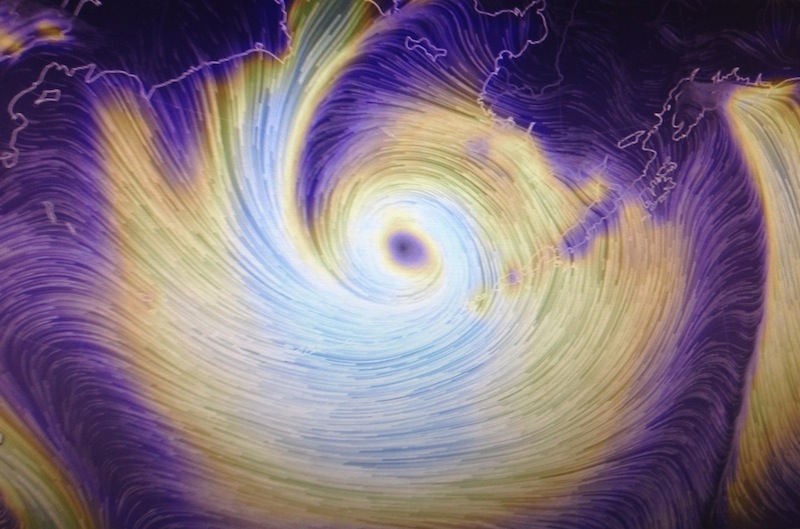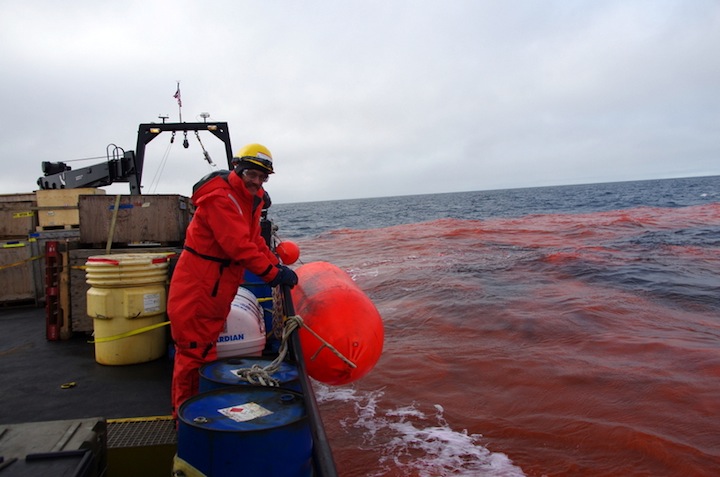Arctic Tracer Release Experiment (ARCTREX): Applications for Mapping Spilled Oil in Arctic Waters
Reports from the Field: 2014 Cruise
During the 2014 cruise in the Chukchi Sea, Dr. Peter Winsor will be posting updates on the progress of the experiment. Click on each date below to expand the report of activities performed. |  Image courtesy of Norseman Maritime Image courtesy of Norseman Maritime |
Saturday, September 6, 2014
| Report 1 ARCTREX is now underway! The science party consisting of Peter Winsor (UAF, PI), Bob Chant (Rutgers), Harper Simmons (UAF), Hank Statscewich (UAF), Eli Hunter (Rutgers), Jack McSweeney (Rutgers), and Pete Shipton (UAF) departed from Fairbanks on an ERA flight to Deadhorse at 11:45 am. Nice flying conditions and good visibility below the cloud deck allowed for an easy touchdown at 1 pm. Sheyna Wisdom (Fairweather) met us at the Deadhorse Aviation Center. We transferred to a bus that took us through the oil fields to West Dock where we did a ship-to-ship transfer to the Norseman II vessel that is going to be our home for the next 10 days. We had a nice dinner and a safety briefing with deck boss, Scotty, that finished at 8:30 pm. Part of the science gear was loaded, and we moved more science gear around, including drums of Rhodamine dye and propanol and our Acrobat winch. Harper Simmons got his microstructure winch set up on the aft deck. We are now on standby until all the gear arrives. Everyone is anxious to get going and is in good spirits. |
Sunday, September 7, 2014
| Report 2 Morning started with breakfast and safety meeting. Gear is being loaded on West Dock, and we are waiting for the gear to arrive on the Norseman II. The weather forecast is looking better. 10:10 am: The Alaska Marine Service boat is upside of the NII. Loading of gear onto the NII is starting. 11:10 am: Offloading from AMS to NII is done! We will steam to just offshore of Wainwright and get the drifters onboard tomorrow night using the Tukpuk. ETA is approximately 6 pm tomorrow (Monday, 8th). 9:00 pm: We are steaming towards Wainwright and the dye release location. We are currently at 71° N, 152° W with a beautiful sunset outside and calm seas. Harper has installed the microstructure system, The Rutgers group worked on the the dye release equipment, 3 gliders and the towed Acrobat system were prepped, and we are looking forward to starting science sampling tomorrow. Everyone is excited! |
Monday, September 8, 2014
| Report 3 7:30 am: We are still steaming to just offshore of Wainwright to rendezvous with the Westward Wind in order to do a ship-to-ship transfer of ocean drifters. 5:45 pm: We are nearing Wainwright and are currently at 70° 58' N, 159° 6' W. It is overcast with 10 kt winds, and seas are at 4 ft. We are inside the ACC with a balmy SST of 7° C and SSS of 30.8 ppt. 11:00 pm: The 34' vessel Tukpuk from Wainwright with Captain Blair heroically made one last, late run out to meet with the NII and transfer drifters in growing seas at 10 pm. All 30 drifters made it across and were activated on deck for coms check by Jack and Pete. We deployed the towed instrument called the Acrobat and plan to tow it through the night from Wainwright to the dye release site. |
Tuesday, September 9, 2014
| Report 4 We towed the Acrobat system offshore of Wainwright to the dye release site. We saw a really exciting cross section that shows large frontal systems and changes in hydrography as we cut across the Chukchi shelf. We recovered the Acrobat at 16:40 UTC at 71° 10.5' N, 162° 30.8' W. We prepared our three gliders and all three were deployed in this area. One of the gliders is carrying passive acoustic sensors to monitor marine mammals in real time, a project funded by AOOS and in collaboration with Mark Baumgartner (WHOI) and Kate Stafford (UW). Another glider will do a large-scale hydrographic survey over the next 18 days around the Hanna Shoal area, while the third glider is equipped with a Rhodamine dye fluorometer to help us with mapping the dye. |

Dye release off the stern of the Norseman II
Wednesday, September 10, 2014
| Report 5 How to track dye? We have had a full exciting day and have tracked the dye using the Norseman II's throughflow water sampling system, which we equipped with a Rhodamine fluorometer, and "mowing the lawn" with our towed Acrobat system. The captain of the ship has to make 50-150 turns per day while we paint a radiator pattern across the ocean with our instruments, in order to map the dye in time and space. Everyone in the science party onboard is now split into two main groups (day and night shift) in order to sample the dye 24/7. An example plot of a completed dye map is shown below. The dye had a concentration of ~1000 parts per billion (ppb) about an hour after the release, and it has now come down to about 100-200 ppb. Surprisingly, after more than 24 hrs, the dye is still visable to the naked eye. We think this is mainly because of the very clear surface waters. We will continue to survey the dye patch throughout the night and all day tomorrow as it disperses and spreads over time, creating one complete dye map every 2-4 hrs. |

Map of dye concentrations
Thursday, September 11, 2014

Jack McSweeney displaying some of the dye used.
It is 2:00 am here and we are officially halfway through the nightshift! Lots of coffee has been consumed, which has helped things move along smoothly. It is snowing and there is a bit of a swell, but spirits are high.
Eli, Pete, Steve and Jack are taking turns watching the Acrobat flight paths and keeping an eye on the movement of the patch. The patch seems to be moving southeast, running adjacent to the front that the drifters ended up in. The surface mixed layer is about 15m deep and the dye is trapped there by a sharp halocline.
We are also currently waiting for one of the gliders to intercept the patch and collect additional data. This is going to be one well-studied patch of dye!!
The dye was still visible as of sundown, so we are all curious what it will look like in the upcoming daylight. The water is very clear here, so it is hard to guess how long the dye will be visible. Any guesses?

The Rutgers dye release team - Eli Hunter,
Jack McSweeney, and Bob Chant
Friday, September 12, 2014
We spent Thursday and the first part of Friday mapping both the dye patch and conducting larger-scale hydrographic surveys to understand how the background circulation and hydrography affect the dispersion of the dye.
Scientifically, we already have some exciting and surprising results. We think that the detailed dispersion of the dye patch is strongly affected by the extreme stratification of the offshore northeastern Chukchi Sea. This stratification is a result of very fresh surface layers, caused by local sea ice melt, resting on top of a water mass that is extremely dense, created in wintertime by salt expelled during sea ice freezing. This results in cold and salty waters that are near or at the freezing point.
Saturday, September 13, 2014
Poor weather! We towed the Acrobat system overnight towards the Alaskan-Arctic coastline through strong winds and building seas. We decided to try to seek some shelter outside Wainwright. The strong winds are a result of a huge low-pressure system centered over northern North Pacific, just south of the Aleutian Island chain. This system is larger than Alaska, about 1200 miles across. The northern part of this low is causing the high easterly winds we are currently experiencing. Right now we are seeing consistent winds at 30 knots nearshore. We are currently heading north along the Arctic coast and will try to head offshore and back west tomorrow morning to see if ocean conditions allow us to continue our science activities.

Visualization of winds around the low pressure system via a
cool on-line weather visualization (click to enlarge)
Monday, September 15, 2014
We injected the second round of dye around 7 pm AKT last night. Through the use of the HF Radar surface current maps and our towed CTD hydrography, we choose a much more dynamic region for the injection - due north of Blossom Shoals at 70° 40.984' N, 162° 2.75' W. It has been a very exciting evening!
About 30 minutes after the injection, we deployed 28 drifters in a tight cluster. The dye has been screaming along at ~30 cm/s toward the NW, and we believe it has subducted beneath the surface at the edge of a front. From about midnight until now (10 am AKT), there is no surface expression of the dye and we are completely reliant on the ACROBAT to track the plume. The maximum dye concentration is hovering at about 25 m depth, even though the injection was at 7 m depth. Glider 159 is chugging away from the last dye injection to our current position, we believe it will arrive here later this evening to assist with the patch survey.

Temperature in depth and time as measured by Glider 159
as it approaches the 2nd dye release area.




 Recovered drifters piled up on the aft deck
Recovered drifters piled up on the aft deck
